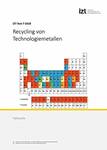Recycling of technology metals
Abstract
This transformation field analysis was prepared as part of the project "Evolution2Green - Transformation Pathways to a Green Economy: Shaping the Path Change". As one of four studies from the field of raw materials, it examines the recycling of technology metals. Together with the digitalisation of the economy and society, the spread of environmental technologies is leading to an increasing demand for technology metals. Due to their properties, they are essential for the functionality of environmental technologies. However, the raw material supply of technology metals is by no means secure and could therefore become an obstacle to a "green" transformation. Although recycling of technology metals is an important approach for sustainable resource management, its potentials have hardly been tapped to date. The paper describes the transformation field and the actors involved. The study identified path dependencies that prevent a transformation towards a sustainable economy and analysed relevant transformation approaches. The recycling of technology metals encounters the following path dependencies in particular: The dissipative use of technology metals in end products makes recycling difficult. The collection of waste containing technology metals and the integration of this waste into the most suitable recycling chains is insufficient. This is especially true for end-of-life products from the consumer sector. The reprocessing methods for end-of-life products and scrap are still largely designed for mass flows. Shredding products containing technology metals without pre-shredding leads to the distribution of technology metals in all output streams and thus to large losses. Considerable quantities of end-of-life devices and products containing technology metals do not flow back into the regulated materials cycle. This is due to legal and illegal exports of end-of-life products to developing and emerging countries: Internationally, recycling of technology metals is only possible in isolated cases and for a few waste fractions. Volatile prices, as can be seen for rare earth elements, for example, prevent investments in facilities for recycling technology metals. The path dependency is particularly pronounced in the dissipation of technology metals. Due to increasing miniaturisation and power compression, ever lower concentrations of technology metals are used for comparable functions. At the same time, the diversity of substance and material combinations is increasing. This accelerates the dissipation of technology metals. The development of recycling processes can hardly keep pace with this. For a transformation away from mass-based recycling to recycling that leads technology metals into metallurgically high-quality recycling paths, eco-design, retro-logistics, pre-shredding and global recycling partnerships are important approaches.
